Artículos SCI
2012
2012
Operando DRIFTS study of the redox and catalytic properties of CuO/Ce1−xTbxO2−δ (x = 0–0.5) catalysts: evidence of an induction step during CO oxidation
Martinez-Arias, A.; Hungria, A. B.; Fernandez-Garcia, M.; Iglesias-Juez, A.; Soria, J.; Conesa, J. C.; Anderson, J. A.; Munuera, G.Physical Chemistry Chemical Physics, 14 (2012) 2144-2151
Show abstract ▽
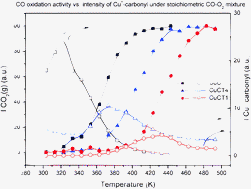
Catalysts of 1 wt% copper oxide supported on cerium oxide or cerium–terbium mixed oxides are comparatively examined with respect to their redox and catalytic properties for CO oxidation. Characterization of the catalysts had shown that they contain highly dispersed CuO-type entities on the corresponding nanostructured fluorite supports with copper dispersion increasing with increasing amounts of terbium in the support. In contrast, the CO oxidation catalytic activity decreases with increasing amounts of terbium in the support. On the basis of operando-DRIFTS experiments, one of the factors that could explain such behaviour is related to the greater difficulty in generating reduced copper sites active for the reaction in the presence of terbium, which in turn is evidenced to constitute an induction stage. Analysis of the redox properties is complemented by XPS which confirms the greater resistance to copper reduction in the presence of terbium.
Febrero, 2012 | DOI: 10.1039/C1CP23298C
Materiales Nanoestructurados y Microestructura
An international round-robin calibration protocol for nanoindentation measurements
Cabibbo, M; Ricci, P; Cecchini, R; Rymuza, Z; Sullivan, J; Dub, S; Cohen, SMicron, 43 (2012) 215-222
Show abstract ▽
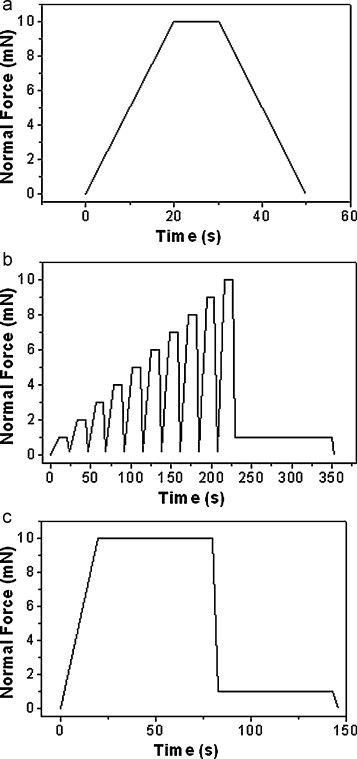
Nanoindentation has become a common technique for measuring the hardness and elastic–plastic properties of materials, including coatings and thin films. In recent years, different nanoindenter instruments have been commercialised and used for this purpose. Each instrument is equipped with its own analysis software for the derivation of the hardness and reduced Young's modulus from the raw data. These data are mostly analysed through the Oliver and Pharr method. In all cases, the calibration of compliance and area function is mandatory. The present work illustrates and describes a calibration procedure and an approach to raw data analysis carried out for six different nanoindentation instruments through several round-robin experiments. Three different indenters were used, Berkovich, cube corner, spherical, and three standardised reference samples were chosen, hard fused quartz, soft polycarbonate, and sapphire. It was clearly shown that the use of these common procedures consistently limited the hardness and reduced the Young's modulus data spread compared to the same measurements performed using instrument-specific procedures. The following recommendations for nanoindentation calibration must be followed: (a) use only sharp indenters, (b) set an upper cut-off value for the penetration depth below which measurements must be considered unreliable, (c) perform nanoindentation measurements with limited thermal drift, (d) ensure that the load–displacement curves are as smooth as possible, (e) perform stiffness measurements specific to each instrument/indenter couple, (f) use Fq and Sa as calibration reference samples for stiffness and area function determination, (g) use a function, rather than a single value, for the stiffness and (h) adopt a unique protocol and software for raw data analysis in order to limit the data spread related to the instruments (i.e. the level of drift or noise, defects of a given probe) and to make the H and Er data intercomparable.
Febrero, 2012 | DOI: 10.1016/j.micron.2011.07.016
Materiales y Procesos Catalíticos de Interés Ambiental y Energético
Rapid microwave-assisted synthesis of one-dimensional silver–H2Ti3O7 nanotubes
Rodriguez-Gonzalez, V; Obregon-Alfaro, S; Lozano-Sanchez, LM; Lee, SWJournal of Molecular Catalysis A-Chemical, 353 (2012) 163-170
Show abstract ▽
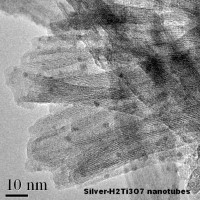
The formation of silver hydrogen trititanate nanotubes, based on the controllable microwave-assisted hydrothermal nanocrystalline TiO2 transition, was investigated by means of XRD, UV–vis–DRS, Raman, FESEM and HRTEM. The results show that the rapid formation of H-trititanate nanotubes is achieved by self-assemblage of silver nanoparticles in which the lamellar intermediates react with NaOH in hydrothermal conditions. The presence of Ag° nanoparticles in the precursor promotes rapid and more complete formation of layered H2Ti3O7 nanotubes. After reacting for 4 h without subsequent thermal treatment, the inner diameters of the cylinder-like nanotubes are in the range of 3.6–4.0 nm, while their outer diameters are in the range of 7.6–8 nm. In addition, some straight nanotubes form bundles which are hundreds of nanometers in length. As-synthesized ultrathin nanotubes and crystalline precursors were evaluated by methyl orange dye (MOD) UV photo-oxidation. The complete degradation of MOD is achieved after 3.5 h of UV irradiation in the presence of silver–TiO2 nanocomposites, resulting in 50% of dye mineralization.
Febrero, 2012 | DOI: 10.1016/j.molcata.2011.11.020
Nanotecnología en Superficies y Plasma
Electrochromic Behavior of WxSiyOz Thin Films Prepared by Reactive Magnetron Sputtering at Normal and Glancing Angles
Gil-Rostra, J; Cano, M; Pedrosa, JM; Ferrer, FJ; Garcia-Garcia, F; Yubero, F; Gonzalez-Elipe, ARACS Applied Materials & Interfaces, 4 (2012) 628-638
Show abstract ▽
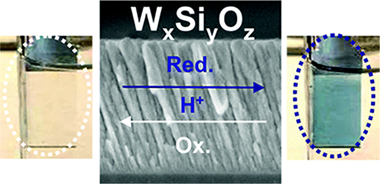
This work reports the synthesis at room temperature of transparent and colored WxSiyOz thin films by magnetron sputtering (MS) from a single cathode. The films were characterized by a large set of techniques including X-ray photoelectron spectroscopy (XPS), Rutherford backscattering spectrometry (RBS), Fourier transform infrared (FT-IR), and Raman spectroscopies. Their optical properties were determined by the analysis of the transmission and reflection spectra. It was found that both the relative amount of tungsten in the W–Si MS target and the ratio O2/Ar in the plasma gas were critical parameters to control the blue coloration of the films. The long-term stability of the color, attributed to the formation of a high concentration of W5+ and W4+ species, has been related with the formation of W–O–Si bond linkages in an amorphous network. At normal geometry (i.e., substrate surface parallel to the target) the films were rather compact, whereas they were very porous and had less tungsten content when deposited in a glancing angle configuration. In this case, they presented outstanding electrochromic properties characterized by a fast response, a high coloration, a complete reversibility after more than one thousand cycles and a relatively very low refractive index in the bleached state.
Febrero, 2012 | DOI: 10.1021/am2014629
Materiales Nanoestructurados y Microestructura
Nanoecotoxicity effects of engineered silver and gold nanoparticles in aquatic organisms
Lapresta-Fernandez, A; Fernandez, A; Blasco, JTrAC Trends in Analytical Chemistry, 32 (2012) 40-59
Show abstract ▽
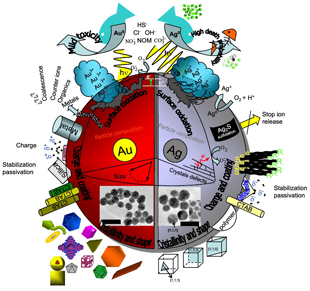
Engineered nanoparticles (ENPs) are increasingly being incorporated into commercial products. A better understanding is required of their environmental impacts in aquatic ecosystems.
This review deals with the ecotoxicity effects of silver and gold ENPs (AgNPs and AuNPs) in aquatic organisms, and considers the means by which these ENPs enter aquatic environments, their aggregation status and their toxicity. Since ENPs are transported horizontally and vertically in the water column, we discuss certain factors (e.g., salinity and the presence of natural organic materials), as they cause variations in the degree of aggregation, size range and ENP toxicity. We pay special attention to oxidative stress induced in organisms by ENPs.
We describe some of the main analytical methods used to determine reactive oxygen species, antioxidant enzyme activity, DNA damage, protein modifications, lipid peroxidation and relevant metabolic activities. We offer an overview of the mechanisms of action of AgNPs and AuNPs and the ways that relevant environmental factors can affect their speciation, agglomeration or aggregation, and ultimately their bio-availability to aquatic organisms.
Finally, we discuss similarities and differences in the adverse effects of ENPs in freshwater and salt-water systems.
Febrero, 2012 | DOI: 10.1016/j.trac.2011.09.007
- ‹ anterior
- 338 of 422
- siguiente ›














